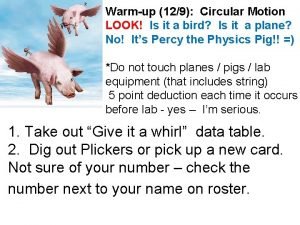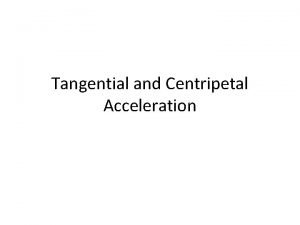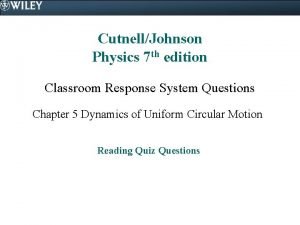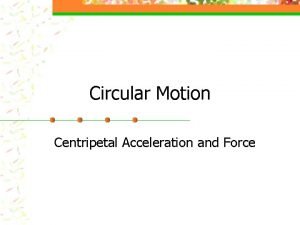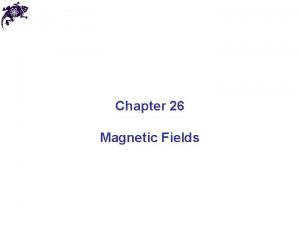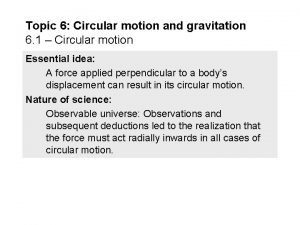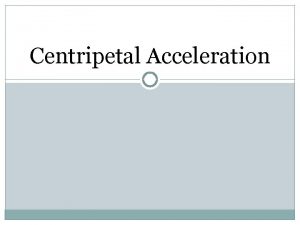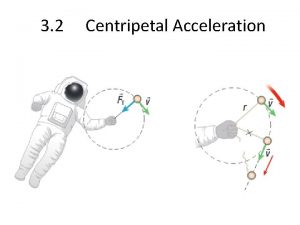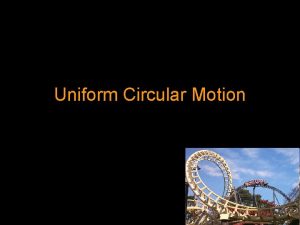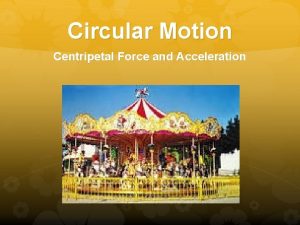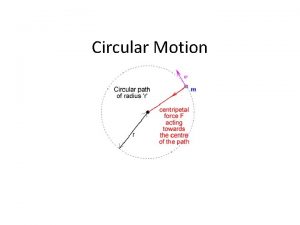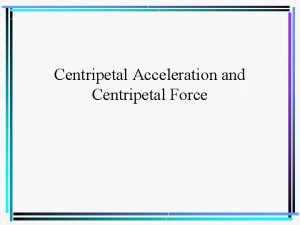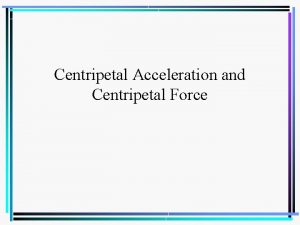Circular Motion Chapter 9 Centripetal Acceleration Uniform circular











- Slides: 11

Circular Motion Chapter 9

• Centripetal Acceleration • Uniform circular motion - dynamics Content Objective

• Uniform circular motion: motion in a circle of constant radius at constant speed • Instantaneous velocity is always tangent to the circle. • The magnitude of the velocity is constant: v 1 =v 2=v Uniform Circular Motion

• The acceleration, called the centripetal acceleration, points toward the center of the circle. • The magnitude of centripetal acceleration is: AR=V 2/R Centripetal Acceleration

• For an object to be in uniform circular motion, Newton’s 2 nd law requires a net force acting on it. This net force is called centripetal force: • Physically, the centripetal force can be the tension in a string, the gravity on a satellite, the normal force of a ring, etc. Dynamics of Uniform Circular Motion

• A centrifuge works by spinning very fast. A small object in the tube requires a large centripetal force. When the liquid can’t provide such a large force, the object will move (sink) to the end of the tube. Centrifuge

Example: Ultracentrifuge • The rotor of an ultracentrifuge rotates at 50, 000 rpm (revolutions per minute). A particle at the top of a test tube is 6. 00 cm from the rotation axis. Calculate its centripetal acceleration, in “g’s. ”

• Car driving on a wall • When a car goes around a curve, there must be a net force toward the center of the circle of which the curve is an arc. If the road is flat, that force is supplied by friction. Highway Curves: Banked and Unbanked

• If the frictional force is insufficient, the car will tend to move more nearly in a straight line, as the skid marks show. Highway Curves: Banked and Unbanked

• Banking the curve can help keep cars from skidding. When the curve is banked, the centripetal force can be supplied by the horizontal component of the normal force. In fact, for every banked curve, there is one speed at which the entire centripetal force is supplied by the horizontal component of the normal force, and no friction is required. Highway Curves: Banked and Unbanked

• Answer questions 8 -12 on page 133 • In your notebook – write question and answer. Activity
 Vertical net
Vertical net Formula for centripetal acceleration in circular motion
Formula for centripetal acceleration in circular motion Radial acceleration formula
Radial acceleration formula Tangential acceleration and centripetal acceleration
Tangential acceleration and centripetal acceleration Centripetal acceleration unit
Centripetal acceleration unit Tangential speed
Tangential speed Centripetal acceleration physics classroom
Centripetal acceleration physics classroom Missy's favorite ride at the topsfield fair is the rotor
Missy's favorite ride at the topsfield fair is the rotor Spiral helix
Spiral helix Is centripetal acceleration a scalar or vector quantity
Is centripetal acceleration a scalar or vector quantity 6-1 centripetal acceleration and force
6-1 centripetal acceleration and force 6-1 centripetal acceleration and force
6-1 centripetal acceleration and force

